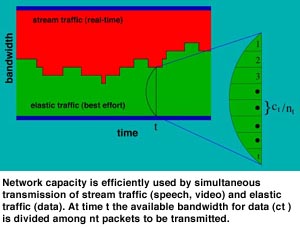

by Annette Kik and Henk Nieland
Network providers offering integrated services aim at optimal use of the available capacity. The best method to satisfy the very diverse user requirements also when the network is almost full, is to allot to each data transmission an equal portion of the bandwidth. This result follows from research at CWI on queueing models for performance analysis of telecommunication systems with integrated services.
In integrated services like (mobile) telephone with Internet, Web browsing or Internet with video communication, the various traffic flows need different treatment. For example, speech should not suffer much delay, lest it becomes incomprehensible, whereas for e-mail this is less problematic. In dealing with these problems it makes sense to distinguish between ‘stream’ traffic and ‘elastic’ traffic. The first mainly consists of real-time connections (telephone, video), which are prone to delay in the transmission. This requires some guarantee in capacity. Elastic traffic (bulk data, e-mail) allows fluctuations in transmission speed as long as the total transmission time remains ‘acceptable’. The present Internet is focused on handling elastic traffic: transmission time increases with the number of users.
The network can be used more efficiently by integrating stream and elastic traffic. For example, pauses in a telephone conversation can be used for sending e-mail. Since stream traffic varies (eg, the number of phone calls), so does the capacity for elastic traffic. Efficiency is improved by applying the method of ‘processor sharing’, in which every user is immediately allotted an equal portion of the bandwidth. Here the average waiting time is determined by ‘first order’ factors like the mean size of the data rather than the variance (in First-Come-First-Served models the dependence on variance can be detrimental to performance). CWI research showed that this favourable feature of processor sharing is preserved under varying network capacity.

In collaboration with Dutch Telecom (KPN Research) the optimal integration strategy for stream and elastic traffic was found to be a division of the bandwidth into two distinct parts. One part is reserved for elastic (data) traffic only, in the other preference is given to stream traffic. If the latter needs less capacity, the unused capacity is given to the elastic traffic. This strategy provides some protection for both types of traffic, as opposed to using the ‘law of the jungle’, which gives every user instant access if capacity is available. Implementation in the switches of a network both guarantees quality-of-service and achieves a high network efficiency.
Integrated services in mobile communication is at present a focal point of interest, as is demonstrated, for example, by considerable media attention for the Wireless Application Protocol (WAP). Current research at CWI concerns comparison of several integration strategies of data and real-time in a mobile network. Here performance analysis is even more important than in fixed networks, because the capacity is much more limited.
Please contact:
Sem Borst - CWI
Tel: +31 20 592 4092
E-mail: Sem.Borst@cwi.nl
Sindo Núñez-Queija - CWI / INRIA
Tel: +31 20 592 4168 / +33 4 9238 7637
E-mail: sindo@cwi.nl / rnunez@sophia.inria.fr